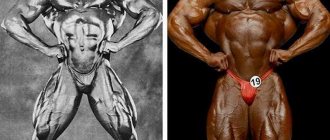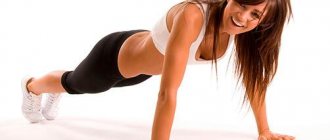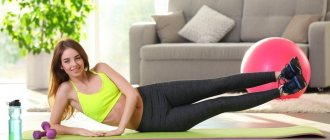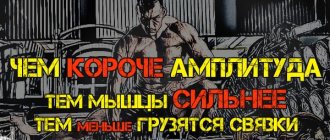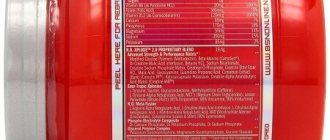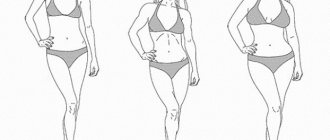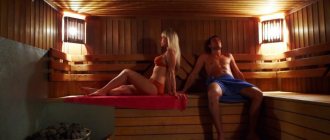Jay Cutler is one of the cult personalities of modern bodybuilding. He became Mr. four times. Olympia, pushing Ronnie Coleman on the podium in 2007 and Dexter Jackson in 2009.
He is the only modern bodybuilder to regain a title after losing it, and the third in the history of bodybuilding after Arnold Schwarzenegger and Franco Columbo. His list of achievements includes many other titles, including three wins in a row at the Arnold Classic.
In this article, we have collected interesting facts from the life of bodybuilder Jay Cutler: biography, interviews, achievements, training features, as well as an example of a week’s training in preparation for the Mr. competition. Olympia.
Reading the following interview with the outstanding bodybuilder Jay Cutler, you will find a beautiful tale about how to do bodybuilding correctly: about nutrition, training and the importance of patience and consistency.. and not a word about pharmacology, which, as you know, is the leading engine of all modern bodybuilding, which has long ceased to be natural. This is confirmed by the words of one of the last natural bodybuilders, Michael Ashley, as well as the anonymous confession of one of the pros.
Main thoughts:
Jay Cutler on nutrition: “.. I began to progress rapidly from the moment I began to carefully follow the nutrition program that was drawn up for me”
Jay Cutler on training: “...I always prefer heavy free weights”
Jay Cutler: “...after I became the first on Mr. Olympia, I never went over 183kg on squats and 12-15 reps."
Jay Cutler on training: “For me, training intensely means resting less between sets.”
Jay Cutler on training: “.. today I don’t train with heavy weights because I don’t want to get injured.. it’s important to train by listening to your body”
Jay Cutler on nutrition: “.. in nutrition I have always tried to find the line between having lean muscle mass and not losing it.. when my diet contains 400 g of carbohydrates, I begin to gain fat mass...”
Jay Cutler about training: “... usually I train two days in a row, the third is rest; four times a day: two cardio sessions at home and two workouts in the gym"
Jay Cutler on nutrition: "... diet is one of the most important factors for success... none of the aspiring bodybuilders eat enough, none of them eat enough to be healthy"
| Bodybuilder Jay Cutler |
| Website: www.jaycutler.com Instagram: @jaycutler Date of Birth: August 3, 1973 Place of Birth: Las Vegas, USA |
| Anthropometric data 1 |
| Height: 178 cm Off-season weight: 132 kg Competition weight: 118 kg Biceps: 56 cm Chest: 150 cm Thigh: 76 cm Waist: 86 cm Calves: 51 cm |
We recommend : Arnold Schwarzenegger's Nutrition Principles
Childhood and youth
Jason (Jay) Cutler was born in 1973 in Worcester, Massachusetts. He lived on a farm and from childhood was accustomed to hard physical labor. Later, Jay helped his brother at a construction site: the work not only strengthened his muscles, but also taught him discipline.
The latter was not at all superfluous - young Cutler constantly changed schools and was not distinguished for diligence. However, the future athlete was very popular among his classmates and excelled in sports.
At school, Jay was an irreplaceable player on the football team, which helped him enroll in college to study law. In college, Cutler unexpectedly became interested in bodybuilding, and this determined his future fate.
Anthropometric data
- Height: 176 cm
- Competition weight: 121 kg
- Off-season weight: 141 kg
- Biceps circumference: 57 cm
- Waist circumference: 86cm
- Thigh circumference: 79 cm
- Shin: 51 cm
- Neck circumference: 50cm
- Bench press: 250 kg
- Squats: 320 kg
- Deadlift: 305 kg
During his school years, Jay often traveled and constantly changed schools. He did not suffer from lack of attention and was quite popular. At school, Jay played football professionally. After successfully graduating from high school in 1991, he attended Quinsigamond Community College and received a degree in criminal justice. Since Jay did not participate in college sports, he took up bodybuilding on his own, and very soon achieved impressive results.
Jay is often compared to 22-year-old Lee Haney. Both achieved amazing success at a fairly young age. Moreover, Cutler, like Haney, is impeccable in his judgment. After receiving his pro card in the city of Dallas, he made the seemingly illogical statement that he did not plan to compete for the next year! Considering that the ink was not yet dry on his contract with the Widers, this was crazy. However, Cutler was adamant.
Today, Jay Cutler is 37 years old, his height is 176 cm. His weight must be maintained in accordance with the requirements of bodybuilding fashion, so during competitions he is 125 kg. During the off-season, his weight is equal to that of any professional bodybuilder. His weight can approach 145 kg during the bulking phase.
Jay took part in the filming of a large number of videos dedicated to preparation for the Mr. Olympia competition, and he also has his own videos about his constant training. Jason is also the direct author of the book " Jay Cutler's No Nonsense Guide to Successful Bodybuilding ."
Today Jay Cutler is a four-time Mr. Olympia . Moreover, he is considered the only bodybuilder in IFBB history to regain the Mr. Olympia after losing (2008 to Dexter Jackson).
Jay Cutler. Life of a Bodybuilder Part 1
Start of a sports career
Even before serious training, Jay easily bench pressed 140 kg and believed that he could get into the desired shape very quickly. However, the reality turned out to be harsher: despite intense training and proper nutrition, there was no tangible progress. Jay redoubled his efforts, but achieved only a decrease in muscle mass and stable fatigue. It turned out that the reason was improper training, too long sets and frequent repetitions.
To achieve the desired result, the novice athlete had to study the literature and take advice from coaches. Jay carefully studied the capabilities of his own body and tried various techniques. As a result, he managed to catch the desired wave and began to quickly build muscle mass. At the age of 20, Cutler won his first victory and became the NPC Iron Bodies Invitationa junior heavyweight champion.
On the wave of success, Cutler moved to California and performed at the first “Night of Champions” in his career, taking first place in the amateur category.
The next step was the transition to the professional category. It took 2 long years: Jay trains fanatically, builds muscle mass and polishes his body. The famous Chris Aceto, a specialist in sports nutrition and bodybuilding, gives a lot of useful advice to a novice athlete.
The result of a professional approach and amazing performance is the ideal body of a future champion: with well-developed muscles, minimal subcutaneous fat, and perfectly defined relief. Jay is completely ready for new victories and has been successfully proving this in all subsequent years.
First victories
Of course, the first victory is absolute motivation. And when you have achieved everything on your own, you are noticed with admiration. The first to conquer the NPC Iron Bodies Invitational was in 1993. And at the amateur “Night of Champions” in 1995, first place also brought the jury’s recommendation to take up bodybuilding seriously, professionally.
Jay realized that he belonged in Los Angeles, California. This is a city where the athletic community, editorial offices of sports magazines, and sports nutrition manufacturers are concentrated.
Jay aroused skeptical, to say the least, attention from local pros. However, he did not experience the reverent delight of their hectic club life, meaningless night vigils and morning coping with the consequences. Cutler did not find here what he was looking for for his development. And he returns.
It took two years, just two years, for this tenacious man to win the US National Amateur Heavyweight Championship and earn a pro card. Since then, he has not missed pro tournaments. And in the late 90s, Chris Aceto, an expert in bodybuilding and sports nutrition, became his friend, mentor and coach.
Having moved with his wife Kerry to the small town of Lake Forest, near Los Angeles, Jay raises his competition weight to 120 kilograms and is preparing to win at Olympia. And it took second place in 2001, then repeated this success in 2003 and 2004. And the Arnold Classic from 2002 to 2004 did not know another winner. But second place at Mr. Olympia was not what suited Jay. We should have passed Ronnie Coleman. And this is... a problem!
Main achievements
Cutler's victorious march begins in 2001. He consistently took second place at the Mr. Olympia tournaments in 2001, 2003 and 2004, while simultaneously becoming the champion at the Arnold Classic tournaments in 2002, 2003 and 2004. However, the coveted first place and the title of All-American “Mr. Olympia” remained out of reach for now - it was firmly occupied by Ronnie Coleman.
Bodybuilding experts believed that the situation would not change in the coming years - Ronnie’s form was more perfect. But Cutler was confident in his abilities. For the sake of the coveted victory, he canceled all minor tournaments, focusing on preparing for Mr. Olympia. Jay signed a contract with Muscle Tech and could afford to give up prize fees. The preparation took two years.
In 2006, “Black Rock” Coleman was overthrown and the first victory of a light-skinned athlete in many years. Cutler gained a foothold on Olympus for 2 years, and then unexpectedly lost the pedestal to Dexter Johnson.
Usually such a loss ends a career, but Jay was an exception. In 2009, he was able to regain his lost championship title and again became Mr. Olympia. There have only been 2 similar cases in the history of bodybuilding. Cutler became the third “returnee” after Schwarzenegger and Columbo and forever wrote himself into the history of athleticism.
After a triumphant return, Jay won the 2010 tournament, but was again a silver medalist the following year. This became a signal for the ex-champion: he wanted to leave the sport in peak shape, without waiting for a series of losses. Cutler announced his retirement in 2013.
Finest hour
Titanic work in 2006 led to success. Kats beat Coleman to take the podium . There has been a lot of controversy about this, but the fact remains. In 2007, the victory was clear. Due to injuries, Coleman found himself in 4th place. Jay received the most prestigious title three more times. In 2008, he was surpassed by Dextor Jackson, but in 2009, Cutler was rehabilitated and again became a prize-winner.
In 2003, I met Phil Heath. Then the aspiring athlete won an amateur competition for the first time. Jay took him under his “wing”. After 3 years, the whole world learned about him. After 5 years, he beat his teacher - in 2011, Phil became the best bodybuilder on the planet. Kats was no longer able to regain his previous title.
| Year | Competitions | Place |
| 1996 | Nationals | 1 in category Heavyweight |
| 1998 | Night of Champions | 11 |
| 1999 | Ironman Pro | 3 |
| 1999 | Arnold Classic | 4 |
| 1999 | Mr. Olympia | 14 |
| 2000 | Night of Champions | 1 |
| 2000 | World Championship Pro | 2 |
| 2000 | Grand Prix England | 2 |
| 2000 | Mr. Olympia | 8 |
| 2001 | Mr. Olympia | 2 |
| 2002 | Arnold Classic | 1 |
| 2003 | Ironman Pro | 1 |
| 2003 | Arnold Classic | 1 |
| 2003 | San Francisco Pro | 1 |
| 2003 | Mr. Olympia | 2 |
| 2003 | Grand Prix Russia | 2 |
| 2003 | Grand Prix England | 1 |
| 2003 | Grand Prix Holland | 1 |
| 2003 | Power Show Pro | 2 |
| 2004 | Arnold Classic | 1 in category Maximum muscularity |
| 2004 | Arnold Classic | 1 |
| 2004 | Mr. Olympia | 2 |
| 2005 | Mr. Olympia | 2 |
| 2006 | Mr. Olympia | 1 |
| 2006 | Grand Prix Austria | 1 |
| 2006 | Grand Prix Romania | 1 |
| 2006 | Grand Prix Holland | 1 |
| 2007 | Mr. Olympia | 1 |
| 2008 | Mr. Olympia | 2 |
| 2009 | Mr. Olympia | 1 |
| 2010 | Mr. Olympia | 1 |
| 2011 | Mr. Olympia | 2 |
| 2011 | Sheru Classic | 2 |
| 2013 | Mr. Olympia | 6 |
Cutler - mentor of champions
Although Cutler has never been involved in formal coaching, he has managed to become a mentor. In 2003, Jay met Phil Heath.
Heath was just starting to compete while Cutler was riding a wave of success. He took the young talent under his protection and became Phil not only a mentor, but also a true friend. Under Cutler's leadership, the young athlete moved into the professional category and began to rapidly improve his athletic performance.
Despite their friendly relationship, Jay and Phil often acted as rivals. In 2011, Heath defeated his mentor for the first time, and since 2012 he has firmly established himself on the sports Olympus.
On the Massachusetts winds
This 176-centimeter tall, 121-kilogram healthy man was born on the third day of August 1973 in Massachusetts.
Until the age of 18, he is absolutely crazy, a reveler, a drinker, a brawler. Silushka is remarkable, but where should I put her? Even hard work on his father’s farm or in a construction company together with his brother could not completely exhaust his youthful energy. From time to time Jay carried pieces of iron. Squeeze 140 kilograms? - Sure, not a problem!
Until 1991, his biography was nothing outstanding. The rural way of life developed a hardworking character that sought outlets in intelligent activities. Therefore, Jay began to visit the gym more often. I studied alone, as best I could and knew. But he knew little. I felt like I was marking time. I started reading books.
Fortunately, in the 90s in America, many now star names sparkled on the sports Olympus. They wrote about them, books were published with training sessions for professional bodybuilders, and advice for beginners. I read something, looked at something from others. And it worked!
Champion Diet
A well-thought-out diet with an emphasis on proteins and complex carbohydrates helped Jay maintain his enormous muscle mass. Protein shakes served as a supplement, but the main nutritional value came from natural products.
Jay ate 12 times a day. The meals did not differ in variety: combinations of egg whites and oatmeal on water alternated with beef, supplemented with rice and vegetables. In between, Cutler consumed whey protein, protein-carbohydrate shakes and creatine. The delicacies included honey and bananas (exclusively for breakfast), as well as ready-made dishes, such as sushi.
The last meal was at night. Jay woke up specifically to drink a protein shake. The calorie content of the diet was stable - about 4000 kilocalories.
During the drying period, Cutler alternated protein and carbohydrate days. By the way, Jay himself considered it wrong to “train” his body for competitions with super-hard cutting: he tried to keep himself in shape even in the off-season. Thanks to a balanced diet, the athlete did not gain more than 7 kg during the rest period.
Nutrition and recovery
Jay Cutler doesn’t particularly focus on diets, for example, his “ drying ” of muscles consists of changing the consumption of proteins and carbohydrates (first there is a reduction in carbohydrates and an increase in protein consumption, then the reverse process occurs, a reduction in proteins, an increase in carbohydrate consumption).
Diet from Jay Cutler
As he himself says, such a cyclical diet helps him better maintain muscle mass and burn fat. Jay Cutler proved the effectiveness of his method by taking 2nd place at the 2001 Mr. Olympia competition (in preparation for this competition, he did not exhaust himself with “cutting” at all).
Jay Cutler is a fan of steaming and going to baths, as he considers this the best way to restore strength after hard training.
For reference: 1 gram of protein contains the same amount of 4.1 kcal as 1 gram of carbohydrates, so Cutler’s manipulations with proteins and carbohydrates work like a charm.
diet consists mainly of protein foods and carbohydrates, he eats 7-8 times (from 4000 to 6000 kcal per day), sometimes meals can last about 1 hour , but he does not enjoy it at all, he believes that eating like this hard work, in addition, to maintain muscle mass, he has to eat at night (mainly protein foods, tilapia fish).
Training program
Cutler developed his own training method in cycles: 2 days of training, a day of rest, then another 3 days of training and rest. The rest of the program was quite traditional: each day was allocated to a specific zone. On the first day, the chest and triceps were worked, on the second - the legs. This was followed by rest and work on the back, shoulders, biceps, and calf muscles. An exception was made for the press: the athlete pumped it up during every session.
Training times ranged from 45 minutes (alone) to 3 hours (with a partner). The warm-up was minimal, but Jay started every morning with half an hour of cardio.
According to the athlete, intense cardio before breakfast perfectly starts the body and sets it up for work.
In each category of exercises, Cutler has his favorites - those that form the main muscle mass. For example, he considers wide-grip pull-ups to be the best workout for the back, a favorite exercise among American prison inmates. The ideal exercise for the triceps is dips, and the best way to build leg muscles is with barbell squats.
Set of exercises
His program is based on the following aspects. Body training should begin with basic exercises, and these exercises must be done under the supervision of a trainer. The use of complex exercises will allow you to gain the necessary body weight much faster . At the next stage, Jay Cutler advises using exercise machines or dumbbells when using isolated exercises. In his excellent workouts, Jay Cutler clearly describes how the barbell is able to engage a large number of muscles and thereby establish a certain balance. Do not forget that in addition to training in the gym, there are also aerobic exercises . These include cycling , skiing, running, swimming, race walking and much more; You can also exercise on exercise bikes and treadmills. Now let’s present to you Jay Cutler’s usual off-season muscle training program :
Monday – Back, rear delta and triceps, abs
- Overhead rows 3 x 12, 8, 8 (3 sets of 12, 8, 8 reps)
- Bent-over barbell row 4 x 12, 8, 8, 8
- Lever rod in the simulator 3 x 12, 8, 8
- Shrugs with a barbell behind your back 3 x 12, 8, 8
- Bent-over dumbbell swings 3 x 12, 8, 8
- French bench press 4 x 12, 8, 8, 8
- Concentrated lying extensions (alternating) 3 x 12, 8, 8
- Triceps on the block (drop set) 3 x 12-6-6
- Press
Tuesday – Thigh and lower leg, abs
- Leg extensions in the simulator 3 x 12
- Barbell squats 3 x 12, 6, 6
- Hack squats 3 x 12, 6, 6
- Leg press 3 x 20, 15, 12
- Shin
- Press
Wednesday – Chest, anterior delta and biceps, abs
- Incline Barbell Press 4 x 12, 8, 8, 8
- Dumbbell bench press 3 x 12, 8, 8
- Incline bench fly 3 x 12
- Seated dumbbell press 4 x 12, 8, 8, 8
- Side swings while standing 3 x 12
- Biceps EZ barbell standing 4 x 12, 8, 8, 8
- Bend dumbbells over the knee 3 x 12, 8, 8
- Hammer 3 x 12, 8, 8
- Press
Thursday – Back, rear delta and triceps, abs
- Overhand row with reverse grip 3 x 12, 8, 8
- Bent-over dumbbell rows (alternating) 4 x 12, 8, 8, 8
- Pulldown while sitting on a block 3 x 12, 8, 8
- Shrugs with barbell 3 x 12, 8, 8
- Back flyes on a block 3 x 12
- Close grip press 4 x 12, 8, 8, 8
- Push-ups 3 x 12-8
- Triceps block (alternating/drop) 3 x 12-6-6
- Press
Friday - Thigh and lower leg, abs
- Lying leg curls 3 x 18, 15, 12
- Straight leg rows 4 x 12, 8, 8, 8
- Hyperextensions with weight 3 x 15, 12, 12
- Lunges in Smith 3 x 12
- Shin
- Press
Saturday – Chest, anterior deltoid and biceps, abs
- Bench press 4 x 12, 8, 8, 8
- Incline Dumbbell Press 3 x 12, 8, 8
- Dumbbell curls lying down 3 x 12
- Seated chest press in Smith 4 x 12, 8, 8, 8
- Sitting side swings 3x12
- Bend EZ bar using the “21″ method 3 x 21
- Dumbbell curls on a music stand 3 x 12
- Hammer sitting over the knee 3 x 12, 8, 8
- Press
Sunday
You can give yourself a day off.
You can read more about each exercise in our section - “Encyclopedia of Exercises”
It may be interesting to compare the bodybuilding program with others:
- Five of the most unusual workouts;
- The first training program (what exercises and how many approaches);
- Phil Heath training program (Mr. Olympia 2012)
What is Jay doing today?
Jay left the big sport gracefully - taking a place in the top ten at the Mr. Olympia tournament in 2013. True, ill-wishers assured that Cutler got the place not so much for his outstanding athletic form, but for his experience and merits in bodybuilding. Nevertheless, the finale of his career turned out to be spectacular and memorable.
Today, forty-six-year-old Jay does not give up training, but does not participate in competitions. He starred in commercials and videos about preparing for the Mr. Olympia competition, and wrote a book on how to succeed in bodybuilding.
His training videos are still sold today. The ex-champion also brings a stable income from his own line of sports nutrition and clothing, Cutler Elite Series.
Jay Cutler now
After leaving big sport, he didn’t waste any time. Kats made films about bodybuilding , where he showed his video training in the gym as an example. His archive contains tapes - “Ripped to Shreds” and “One Step Closer” with detailed instructions on building mass and building super-relief. In 2000, Cutler starred in the film The League, where he played himself.
The athlete travels a lot. In 2020, he visited a sports nutrition exhibition in Moscow and gave an interview. He talked about experiments with nutrition and motivation to work in the gym. There was no official statement from Cutler about his retirement from bodybuilding. Perhaps he will catch up and once again join the ranks of bodybuilders.
DELTA[edit | edit code]
SEATED/STANDING STAND PRESS - S[edit | edit code]
» Stand up straight or sit on a bench with a short, straight back. Hold the barbell with a shoulder-width grip at collarbone level. Elbows point down and back. From this starting position, slowly and under control, press the barbell straight above your head. Return the barbell to the starting position under control.
ARM RAISE TO THE SIDE - R[edit | edit code]
» Stand up straight or sit on a bench with a short, straight back. Hold the dumbbells with your hands straight on the sides of your thighs. Using strictly isolated force of the deltoid muscles, spread your arms straight to the sides. Raise the dumbbells to shoulder level and pause briefly. Slowly lower the dumbbells.
BACK[edit | edit code]
PULL-UPS[edit | edit code]
Move the support to the horizontal bar crossbar. Stand on a support and grab the bar with a grip wider than your shoulders. Step off the support and assume a hanging position with straight arms. Without involving your biceps in the movement, lower your elbows down, thereby pushing your body up towards the bar. When it becomes impossible to rise further, take a static pause and slowly straighten your arms to lower yourself back into the hanging position.
BELT TO THE BELT [edit | edit code]
Stand next to the bar of a barbell lying on the floor. Bend your knees slightly and bend deeply. Grasp the barbell with an overhand grip slightly wider than shoulder width. Lift your body up and lift the bar off the floor. When the body is tilted at an angle of about 45 degrees to the vertical, freeze. From this starting position, pull the barbell towards your waist. But! Don't bend your elbows with your biceps! Instead, try to raise your elbows as high as possible. The elbow pull is the only correct one, since only this technique makes the back muscles work, not the biceps.
WIDE PULL TOP[edit | edit code]
Sit on the seat of a block machine and place your knees under the bolsters. Lower the bolsters and firmly secure your body position. Raise your straight arms up and ask your partner to give you a long straight handle with beveled ends. Grab the beveled ends of the handle and hold it above your head. Straighten your back, fill your chest with inhalation and with a powerful, controlled effort, pull the handle towards your collarbones. The exercise again needs to be done with your elbows, without “including” your biceps.
TRICEPS[edit | edit code]
NARROW BENCH PRESS[edit | edit code]
» Assume a flat bench position as you would for a bench press, but grab the bar with a relatively narrow grip, shoulder-width apart. Remove the barbell from the supports and hold it above your chest with straight arms. Slowly lower the barbell towards your chest. From this position, press the barbell upward powerfully.
PRESS DOWN[edit | edit code]
» Attach a rope handle to the end of the pulley cable. It will allow you to perform the exercise with a neutral grip. Grasp the ends of the handle and pull downward slightly, fixing it at eye height. Using an isolated triceps force, straighten your arms, squeezing the handles down toward your hips.
When dreams come true
In 2006, Coleman lost first place to Jay. It happened! And then Cutler took this place for another three years and did not promise to make it vacant. Unless, of course, you count the failure in 2008 with second place. But he returned it, and for the next 2009 and 2010 he was again the first. Magazines about bodybuilding and bodybuilders race to publish photos of the athlete and interviews with him.
His daily routine, training program. But Jay doesn’t feel sorry. He willingly shares his secrets. Moreover, he had a student, from whom Cutler managed to make a brilliant bodybuilder, so that in 2011 he supplanted Jay on the highest step of the pedestal. Phil Heath, that's who it was.
The loss did not affect the good relationship between teacher and student. Cutler predicted Phil victory at Mr. Olympia 2016. And so it happened.
CHEST[edit | edit code]
INFORMATION IN THE SIMULATOR - R[edit | edit code]
» Press your back firmly against the vertical backrest of the machine. Stretch your arms out to the sides and firmly grasp the handles. Move the handles forward slightly and keep them in the same plane with the vertical axis of the body. This is the starting position. Keeping your body motionless, bring the handles together in front of you with an isolated force of the pectoral muscles. Slowly release the handles.
BENCH PRESS- C[edit | edit code]
Take a lying position on a horizontal bench. Grasp the barbell with an overhand grip, shoulder-width apart. Press the bar up and remove the bar from the supports. Hold the barbell above your chest with straight arms. Slowly bend your elbows and lower the bar toward your chest. Without pausing, press the barbell upward with a powerful explosive force. Do not allow a dangerous arch in the lower back while pressing.
DO YOU KNOW WHAT IS MUSCULAR FASCIA?[edit | edit code]
heavy base and pumping style
This is a dense connective tissue cover that covers our muscles. In fact, all our organs are “dressed” with a similar durable covering. Science calls fascia the soft skeleton of our body, which allows the body to safely experience vibrations and shaking.
The main property of muscle fascia is “shape memory”. When you pump a muscle vigorously, it enlarges and stretches the overlying fascia. After the end of the workout, the fascia, like rubber, exhibits elastic properties and compresses the muscle again, returning it to its original size. However, fascia also has the opposite quality - plasticity. If the fascia is stretched for a long time, then, following the example of plasticine, it will “forget” its previous shape and take on a new one. It is precisely for this reason that a child grows, in which all organs and tissues are covered with fascia while still in the womb.
It would seem that. Why do we, bodybuilders, need to know all this? The fact is that it was an understanding of the anatomy of muscle fascia that led the unknown American trainer Hani Rambod to create an amazingly effective training system that literally shocked the world of modern bodybuilding. Suffice it to say that its most devoted adherents are practically all IFBB professional bodybuilders, including the famous Jay Cutler.
Let's start with the fact that Rambod worked for many years in a provincial fitness club, watching with longing how difficult it was for his amateur clients to grow. Reading the methodological literature, he was perplexed. Strength exercises trigger a protein synthesis reaction inside the muscles, and this process has the character of a natural law that knows no exceptions. If so, why do bodybuilders grow at different rates? Is it really true that for most amateurs, unlike pros, the law is not written? Rambod could not have imagined this. This would mean that an aspirin tablet should act differently on everyone. It turns out that in the body of ordinary amateurs there is some kind of hindrance to muscle growth, and not at all of a biochemical nature. After all, all people belong to the same biological species and therefore have the same homeostasis. Otherwise, amateurs would have to be considered aliens...
Dreaming of finding a magic remedy to accelerate muscle growth, Rambod read a lot of medical literature and regularly surfed the Internet on forums where American bodybuilders discussed their common problems together. That's where the first clue came: stretching. All the great gurus of our time, including Dante Trudel, unanimously spoke about the benefits of muscle stretching. Moreover, Trudel insisted on stretching after each working set!
However, the real insight came to Haney Rambod, as often happens, by accident. They say that an apple fell on Newton’s head, and Einstein discovered the principle of relativity while going up in an elevator... So Rambod, getting ready for work in the morning, one day discovered a “hernia” on the tire of his jeep. The side surface of the tire swelled with a huge lump, ready to burst. At the service center, Hambod was explained that he was let down by a factory defect in the wire frame, which is present in any tire. The wire burst, and powerful internal pressure squeezed out a rather large rubber bubble. Haney changed the tire, he got behind the wheel, and soon, probably, he would have forgotten the morning trouble forever, if...
The fact is that just in the evening before going to bed, Rambod, for the sake of improving his skills, was leafing through a textbook on sports traumatology. By chance, he came across a photo illustrating damage to the muscle fascia. The fascia burst, and a large lump formed at the site of the injury, exactly like the one he had on the splint this morning. The textbook called it a “muscle hernia.” "How so? — Rambod was surprised to himself. “Does the fascia really compress the muscle with such terrible force?”
To answer this question, Rambod had to delve into the specialized medical literature. And exactly! It turned out that in addition to the protective function, the muscle fascia has another one. Muscle tissue is like a sponge and therefore can absorb too much blood. At the end of the physical work, the elastic fascia powerfully compresses the muscles, squeezing the blood out of them back into the bloodstream and thereby saving our heart. However, in the case of bodybuilding, this protective mechanism plays a disservice to bodybuilders. After strength training, the muscle should begin to grow, but the same thing happens to it as to a person in a dense crowd. He is being squeezed so hard from all sides that he can barely breathe.
“Now, if we could ease the pressure of the fascia,” it dawned on Haney, “then the intracellular addition of protein would receive the long-awaited freedom, and the muscle after training would be guaranteed to increase its physical size!”
By the way, along the way, Rambod learned that muscle fascia naturally has different thicknesses. In most people, the fascia is thick and dense, while in a few, on the contrary, it is thin and easily stretchable. “So that’s the difference between amateurs and pros!” - Rambod immediately guessed.
So how do you stretch the fascia? Rambod had to delve back into the medical literature. It turned out that the fibers that make up the fascia tissue have a spiral structure and therefore act like springs: they can stretch elastically. Doctors call this tortuosity. So, inside the fascia there are 3 types of fibers - with maximum, medium and low crimp. When you stretch fascia, all types of fibers straighten and lengthen, but for the least crimped fibers, the stretch becomes critical - to the point of breaking. If you overdo it with stretching, the moderately crimped fibers will completely straighten, and the weakly crimped ones will stretch and break. At the site of the rupture, bleeding occurs, and then inflammation, which ends with scarring with the formation of typical nodules that can be easily felt on the biceps of some amateurs who are overly keen on pumping this muscle. One way or another, as the duration of the tensile load increases, the plastic properties of the fascia begin to take precedence over its elastic qualities. In other words, the fascia is irreversibly stretched.
It must be emphasized that Rambod himself was a practicing bodybuilder and knew that muscle grows only under the influence of critical working weights. So he decided to combine the brutal "base" with stretching the muscle fascia. According to his calculations, heavy weights were supposed to stimulate protein synthesis, which would no longer be constrained by the narrow fascial “stocking”. Looking ahead, it should be said that the effect of using the system exceeded all expectations and made Haney Rambod a star of the first magnitude in the world of modern professional and amateur bodybuilding.
Stimulation phase and stretch phase
However, let's return to the fascia. Rambod decided to stretch the connecting sheath of the working muscle with an isolating exercise in a pumping style. This exercise, like the previous basic one, is performed at the limit of strength. You consciously drive more and more blood into the muscle, trying to maximize its diameter. In this case, between sets you should rest no longer than 30-45 seconds. “Each of us has used the power of our lungs to inflate a rubber balloon,” says Rambod. - Remember, as soon as you were distracted, the air immediately came out of the ball. Same with blood. Do not let it leave the working muscle. Rest less between sets and especially don’t get distracted by extraneous conversations.” Let us remind you once again that pumping repetitions should be fast and jerky, as if you were pressing on the handle of a pump.
And now about the main thing. Through long experiments, Rambod established that there should be only 7 pumping sets. This is a critical load number, beyond which hemorrhages, pain and large-scale scarring of connective tissue begin. Experiments carried out by others have confirmed that increasing the number of sets does not lead to an increase in the effect. Only the number of repetitions differs. Rambod advises experienced athletes to do 8-12 repetitions in a pumping set. For beginners, he recommends up to 20 repetitions. The basic formula of the Haney Rambod system sounds like this: a heavy base in a low-rep mode plus a pumping-isolating exercise. Too easy? No, it’s simple, like most truly brilliant discoveries! Agree, the idea of the relativity of all things cannot be called complicated either...
However, according to Rambod, this is how they grow their overall muscle mass. If one of your muscles has become stagnant and completely refuses to grow, change the order - do isolation before the base. Even if you are an experienced and successful athlete, be sure to try this system! After all, Jay Cutler himself switched to it and assures that in a matter of months he has become much bigger!
By days
